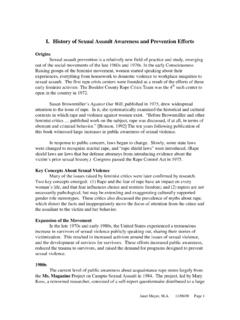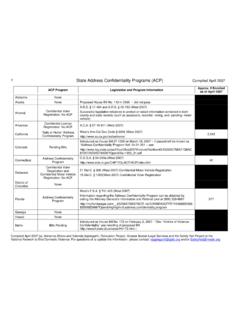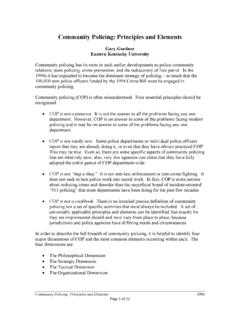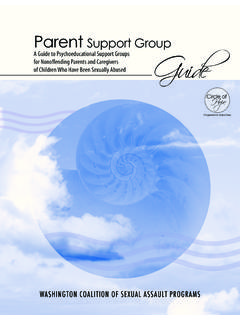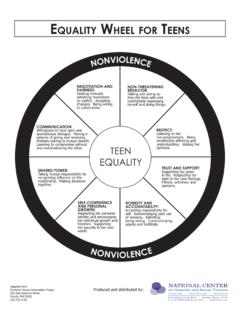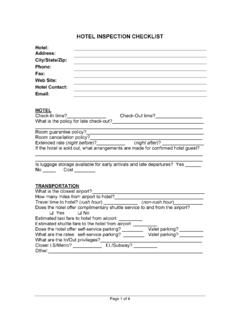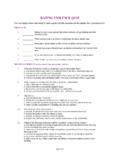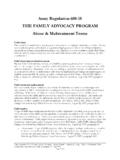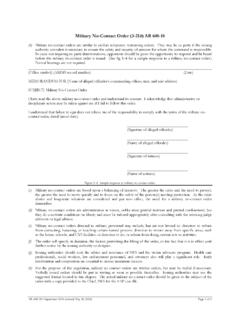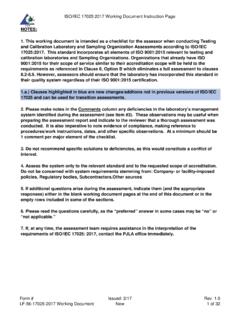Transcription of Counselor’s Treatment Manual - National Center on ...
1 counselor s TreatmentManualMatrix Intensive Outpatient Treatment forPeople With Stimulant Use DEPARTMENT OF HEALTH AND HUMAN SERVICESS ubstance Abuse and Mental Health Services AdministrationCenter for Substance Abuse Treatment1 Choke Cherry RoadRockville, MD 20857 AcknowledgmentsNumerous people contributed to this document, which is part of the Methamphetamine Treatment Project (MTP).The document was written by Jeanne L. Obert, , ; Richard A. Rawson, ; Michael J. McCann, ;and Walter Ling, The MTP Corporate Authors provided valuable guidance and support on this document. This publication was developed with support from the University of California at Los Angeles (UCLA) CoordinatingCenter through Grant No. TI11440. MTP was funded by the Center for Substance Abuse Treatment (CSAT),Substance Abuse and Mental Health Services Administration (SAMHSA), Department of Health and HumanServices (DHHS).
2 The research was conducted from 1998 to 2002 in cooperation with the following institutions:County of San Mateo, San Mateo, CA (TI11411); East Bay Recovery Project, Hayward, CA (TI11484); FriendsResearch Institute, Inc., Concord, CA (TI11425); Friends Research Institute, Inc., Costa Mesa, CA (TI11443); SaintFrancis Medical Center of Hawaii, Honolulu, HI (TI11441); San Diego Association of Governments, San Diego, CA(TI11410); South Central Montana Regional Mental Health Center , Billings, MT (TI11427); and UCLA CoordinatingCenter, Los Angeles, CA (TI11440). The publication was produced by JBS International, Inc. (JBS), underKnowledge Application Program (KAP) contract numbers 270-99-7072 and 270-04-7049 with SAMHSA, Currier served as the CSAT Government Project Officer. Andrea Kopstein, , , served as theDeputy Government Project Officer. Cheryl Gallagher, , served as CSAT content advisor.
3 Lynne MacArthur, , , served as JBS KAP Executive Project Co-Director; Barbara Fink, RN, , served as JBS KAPM anaging Project Co-Director; and Emily Schifrin, , and Dennis Burke, , , served as JBS KAP DeputyDirectors for Product Development. Other JBS KAP personnel included Candace Baker, , Senior Writer;Elliott Vanskike, , Senior Writer; Wendy Caron, Editorial Quality Assurance Manager; Frances Nebesky, ,Quality Control Editor; Pamela Frazier, Document Production Specialist; and Claire Speights, Graphic Artist. DisclaimerThe opinions expressed herein are the views of the authors and do not necessarily reflect the official position of CSAT, SAMHSA, or DHHS. No official support of or endorsement by CSAT, SAMHSA, or DHHS for these opinions or for particular instruments, software, or resources described in this document is intended or should beinferred. The guidelines in this document should not be considered substitutes for individualized client care andtreatment decisions.
4 Public Domain NoticeAll materials appearing in this volume except those taken directly from copyrighted sources are in the public domainand may be reproduced or copied without permission from SAMHSA/CSAT or the authors. Do not reproduce or distribute this publication for a fee without specific, written authorization from SAMHSA s Office of Communications. Electronic Access and Copies of PublicationCopies may be obtained free of charge from SAMHSA s National Clearinghouse for Alcohol and Drug Information(NCADI), 800-729-6686 or 301-468-2600; TDD (for hearing impaired) 800-487-4889; or electronically CitationCenter for Substance Abuse s Treatment Manual : Matrix Intensive Outpatient Treatment forPeople With Stimulant Use Publication No. (SMA) 06-4152. Rockville, MD: Substance Abuse andMental Health Services Administration, OfficePractice Improvement Branch, Division of Services Improvement, Center for Substance Abuse Treatment ,Substance Abuse and Mental Health Services Administration, 1 Choke Cherry Road, Rockville, MD Publication No.
5 (SMA) 06-4152 Printed 2006iiiContentsI. Introduction to the Matrix Intensive Outpatient Treatment for People With Stimulant Use Disorders Approach and Package.. 1 Background.. 1 Matrix IOP Approach.. 2 The Role of the counselor .. 6 Working With Client Co-Leaders and Client Facilitators.. 7 The Matrix IOP Package.. 8 Introduction to the counselor s Treatment Manual .. 9II. The Role of Drug and Breath-Alcohol Testing in Matrix IOP.. 11 Philosophy.. 11 Procedure.. 11 Addressing a Positive Urine Test.. 12 III. Individual/Conjoint Sessions.. 15 Introduction.. 15 Session 1: Orientation.. 17 Session 2: Client Progress/Crisis Intervention.. 19 Session 3: Continuing Treatment Planning.. 21 Handouts for Individual/Conjoint Sessions.. 22IV. Early Recovery Skills Group.. 31 Introduction.. 31 Session 1: Stop the Cycle.. 37 Session 2: Identifying External Triggers.. 40 Session 3: Identifying Internal Triggers.
6 43 Session 4: Introducing 12-Step or Mutual-Help Activities.. 45 Session 5: Body Chemistry in Recovery.. 48 Session 6: Common Challenges in Early Recovery.. 50 Session 7: Thinking, Feeling, and Doing.. 52 Session 8: 12-Step Wisdom.. 55ivCounselor s Treatment Manual : Matrix Intensive Outpatient TreatmentHandouts for Early Recovery Skills Group Sessions.. 56V. Relapse Prevention Group.. 85 Introduction.. 85 Session 1: Alcohol.. 92 Session 2: Boredom.. 94 Session 3: Avoiding Relapse Drift.. 96 Session4: Work and Recovery.. 98 Session 5: Guilt and Shame.. 100 Session 6: Staying Busy.. 102 Session7: Motivation for Recovery.. 104 Session8: Truthfulness.. 106 Session9: Total Abstinence.. 108 Session 10: Sex and Recovery.. 110 Session 11: Anticipating and Preventing Relapse.. 112 Session 12: Trust.. 114 Session 13: Be Smart, Not Strong.. 116 Session 14: Defining Spirituality.. 118 Session 15: Managing Life; Managing Money.
7 120 Session 16: Relapse Justification I.. 122 Session 17: Taking Care of Yourself.. 124 Session 18: Emotional Triggers.. 126 Session 19: Illness.. 128 Session 20: Recognizing Stress.. 130 Session 21: Relapse Justification II.. 133 Session 22: Reducing Stress.. 136 Session 23: Managing Anger.. 138 Session 24: Acceptance.. 140 Session 25: Making New Friends.. 142 Session 26: Repairing Relationships.. 144 Session 27: Serenity Prayer.. 146 Session 28: Compulsive Behaviors.. 148vContentsSession 29: Coping With Feelings and Depression.. 150 Session 30: 12-Step and Mutual-Help Programs.. 153 Session 31: Looking Forward; Managing Downtime.. 156 Session 32: One Day at a Time.. 158 Elective Session A: Client Status Review.. 160 Elective Session B: Holidays and Recovery.. 162 Elective Session C: Recreational Activities.. 164 Handouts for Relapse Prevention Group Sessions.. 165VI. Social Support Group.
8 233 Introduction.. 233 Social Support Group Topics.. 234 AppendicesAppendix A. The Methamphetamine Treatment Project.. 243 Appendix B. Notes on Group Facilitation.. 245 Appendix C. Sample Agreement for Co-Leaders and Client Facilitators.. 247 Appendix D. Acronyms and Abbreviations List.. 249 Appendix E. Further Reading.. 251 Appendix F. Field Reviewers.. 253 Appendix G. References.. 2551 The Matrix Intensive Outpatient Treatment forPeople With Stimulant Use Disorders (IOP) pack-age provides a structured approach for treatingadults who abuse or are dependent on stimulantdrugs. The approach followed in the treatmentpackage was developed by the Matrix Institute inLos Angeles, California, and was adapted for thistreatment package by the Knowledge ApplicationProgram of the Center for Substance AbuseTreatment of the Substance Abuse and MentalHealth Services Administration (SAMHSA). TheMatrix IOP package comprises five components:nCounselor s Treatment Manual (thisdocument)nCounselor s Family Education ManualnCD-ROM that accompanies theCounselor s Family Education ManualnClient s HandbooknClient s Treatment CompanionThe Matrix IOP model and this Treatment pack-age based on that model grew from a need forstructured, evidence-based Treatment for clientswho abuse or are dependent on stimulant drugs,particularly methamphetamine and cocaine.
9 Thiscomprehensive package provides substanceabuse Treatment professionals with an intensiveoutpatient Treatment model for these clients andtheir families: 16 weeks of structured program-ming and 36 weeks of continuing care. BackgroundThe Matrix IOP method was developed initially inthe 1980s in response to the growing numbers ofindividuals entering the Treatment system withcocaine or methamphetamine dependence astheir primary substance use disorder. Many tradi-tional Treatment models then in use were devel-oped primarily to treat alcohol dependence andwere proving to be relatively ineffective in treatingcocaine and other stimulant dependence (Obertet al. 2000). To create effective Treatment protocols forclients dependent on stimulant drugs, treatmentprofessionals at the Matrix Institute drew fromnumerous Treatment approaches, incorporatinginto their model methods that were empiricallytested and practical.
10 Their Treatment modelincorporated elements of relapse prevention,cognitive behavioral, psychoeducation, andfamily approaches, as well as 12-Step programsupport (Obert et al. 2000). The effectiveness of the Matrix IOP approachhas been evaluated numerous times since itsinception (Rawson et al. 1995; Shoptaw et ). SAMHSA found the results of these stud-ies promising enough to warrant further evalua-tion ( , Obert et al. 2000; Rawson et al. 2004). In 1998, SAMHSA initiated a multisite study oftreatments for methamphetamine dependenceand abuse, the Methamphetamine TreatmentI. Introduction to the Matrix IntensiveOutpatient Treatment for People With Stimulant Use Disorders Approach and Package2 counselor s Treatment Manual : Matrix Intensive Outpatient TreatmentProject (MTP). The study compared the clinicaland cost effectiveness of a comprehensive Treatment model that follows a Manual developedby the Matrix Institute with the effectiveness of Treatment approaches in use at eight community-based Treatment programs, includingsix programs in California, one in Montana, andone in Hawaii.
